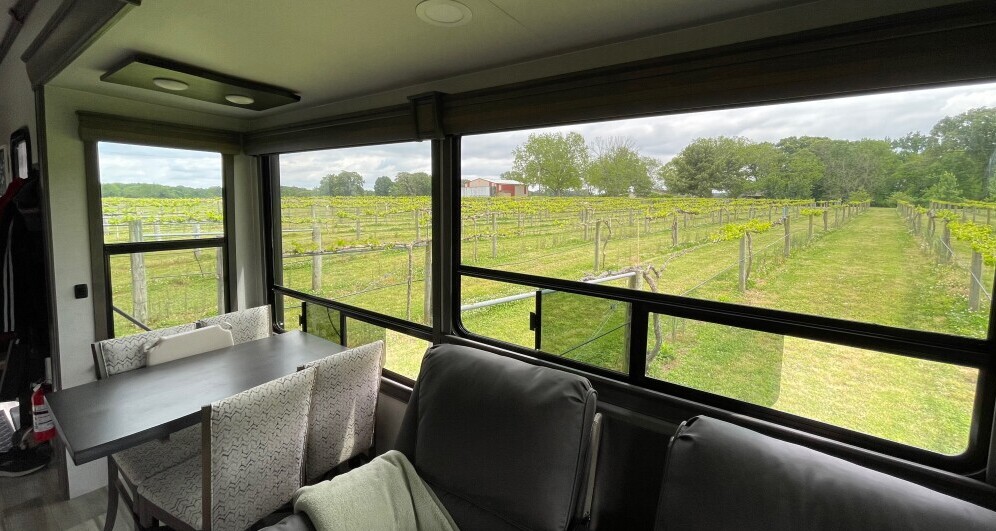When you’re living or traveling in an RV, comfort is everything. You want to stay warm in the winter, cool in the summer, and avoid unnecessary noise from the outside world. That’s why many RVers consider upgrading to dual pane windows—also called thermal pane windows—thinking they’ll improve insulation and temperature control. But are they really worth the cost?
While dual pane windows do offer some benefits, they aren’t the insulation game-changer many people assume. They help with noise reduction, but when it comes to keeping your RV warm or cool, there are cheaper and more effective alternatives. In this post, I’ll break down what dual pane RV windows actually do, compare them to insulation alternatives, and help you decide if they’re the right investment for your RV lifestyle.

Contents
- What Are Standard RV Windows?
- The Reality of Dual Pane Windows
- Cost-Effective Insulation Alternatives
- Condensation & Humidity Control
- Noise Reduction Benefits
- Euro-Style Windows: A Better Alternative?
- FAQ
What Are Standard RV Windows?
Most RVs come equipped with single-pane windows—a basic sheet of glass in a frame that slides open. They provide light, ventilation, and visibility, but they do little in terms of insulation. Heat and cold pass through easily, and in extreme temperatures, you can often feel the temperature difference just by touching the glass.
What Are Dual Pane RV Windows?
Dual pane windows for an RV are made of two layers of glass with a small air gap in between. This design is supposed to create a thermal barrier, reducing heat transfer and making the interior of your RV more comfortable. If you’re familiar with residential double-glazed windows, you might assume that these offer similar benefits. However, that’s not entirely the case.
Are They the Same as Residential Dual-Pane Windows?
No. Residential dual-pane windows are designed with an argon or krypton gas-filled gap between the panes to improve insulation. In contrast, most dual pane windows in RVs do not have this gas-filled layer. Instead, they rely on plain air between the glass, which provides only a minor improvement in insulation compared to single-pane windows.
The Reality of Dual Pane Windows
Insulation & R-Values
Insulation effectiveness is measured using R-values—the higher the number, the better the insulation. Here’s how RV windows compare:
- Single-pane RV windows: R-value of 0.7
- Dual-pane RV windows: R-value of 0.91 (only about 30% better)
- RV sidewalls: R-value between 0.7 and 0.9
Looking at these numbers, it’s clear that dual-pane RV windows don’t provide a major insulation boost. Your RV’s walls already have a similar R-value, and improving window insulation alone won’t drastically change your interior comfort.
Are They Effective in Cold Weather?
Not really. Many RVers assume dual pane windows will keep them significantly warmer in winter, but with only a slight increase in insulation, the difference is minimal. Cold air can still pass through window frames and other areas of the RV, making other insulation strategies far more effective.
Do They Help in Hot Weather?
Again, not significantly. The main issue in hot climates is solar heat gain—when sunlight passes through the glass and heats up the interior. While dual pane windows slightly reduce this effect, they don’t block sunlight the way reflective foil or thermal shades do.
Cost-Effective Insulation Alternatives
If keeping your RV comfortable is your goal, you don’t need to rely on dual pane windows to do it. There are cheaper and more effective ways to insulate your RV.
1. Window Shades & Thermal Curtains
- Why they work: By pulling down window shades, you create an air gap that helps block temperature transfer, much like what dual pane windows try to achieve.
- Effectiveness: A high-quality thermal shade or insulated curtain can achieve an R-value of 2.1—far better than dual pane windows.
- Cost: A set of thermal curtains or reflective shades costs a fraction of what new windows do.
2. Reflective Foil (Reflectix)
- Why it works: Reflectix is a foil insulation that blocks sunlight and reduces heat buildup inside the RV. It’s especially useful for summer camping and works well when paired with window shades.
- Effectiveness: Placing Reflectix over windows can dramatically reduce interior temperatures.
- Cost: A roll costs around $30–$50, making it one of the most cost-effective insulation methods.
3. Vent Covers & Skirting
While windows contribute to heat loss, your RV’s roof vents, doors, and underbelly also let in cold air. Using vent covers and RV skirting during winter camping will keep your rig far warmer than any window upgrade.
Condensation & Humidity Control
Do Dual Pane Windows Prevent Condensation?
No. Condensation happens when warm, moist air inside the RV comes into contact with a cold surface. Since dual pane windows don’t have the gas-filled insulation of residential models, they still get cold, leading to moisture buildup.
How to Reduce Condensation in an RV
- Use a dehumidifier – Keeps interior moisture levels low.
- Ventilate your RV – Open windows or run roof vents to let moisture escape.
- Avoid propane heaters – They produce moisture as they burn fuel.
If you camp in cold or humid environments, investing in humidity control will make a bigger impact than upgrading to dual pane windows.
Noise Reduction Benefits
This is where dual pane windows actually shine. If you often camp in noisy areas—like truck stops, highways, or busy campgrounds—the extra glass layer helps block sound. Many full-time RVers report significant reductions in road and campground noise after upgrading.
If peace and quiet are important to you, dual pane windows might be worth the investment.
Euro-Style Windows: A Better Alternative?
Unlike standard RV windows, Euro-style windows use a hollow-core design that provides superior insulation. These are more common in high-end RVs and truck campers, offering better energy efficiency and noise reduction. If you’re serious about window insulation, Euro-style windows are a better upgrade than standard dual pane models.
FAQ
Question: Do dual pane RV windows make a big difference in winter?
Answer: Not much. Their insulation value is slightly better than single-pane windows, but shades and Reflectix work better for keeping heat inside.
Question: Are they worth it for full-time RVers?
Answer: If you camp in noisy areas, yes—they help with soundproofing. But for insulation? No, there are better options.
Question: Do they prevent condensation?
Answer: No. The best way to prevent condensation is to manage humidity levels inside the RV.
Question: Are Euro-style windows better?
Answer: Yes! They have a hollow-core design that offers superior insulation and noise reduction compared to standard dual pane windows.
What’s your experience with RV dual pane windows? Have they made a noticeable difference in your travels? Share your thoughts in the comments below!
So, are RV dual pane windows worth it? It depends.
- If you want better noise reduction, they’re a solid upgrade.
- If you want better insulation, shades, Reflectix, and humidity control will give you better results for less money.
- If you’re serious about insulation, Euro-style windows are a better investment than standard dual pane RV windows.
Unless you’re willing to spend the extra money for noise reduction, the return on investment just isn’t there.
Safe travels, and stay comfortable out there!
About the Author
Jim has 3.5 years of experience living and traveling full-time in an RV. From “moochdocking” with family and friends to navigating the financial intricacies of RV life, he shares practical advice rooted in firsthand experience. His goal is to help fellow adventurers embrace the RV lifestyle with confidence and ease.
There are no affiliate links in this post but feel free to read our affiliate disclosure.
